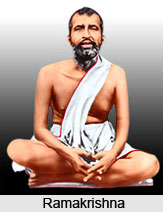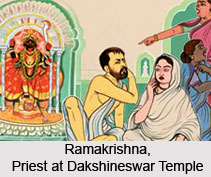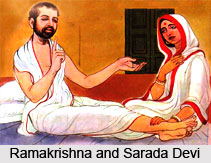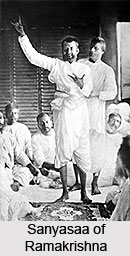 "The grace of God is a wind which is always blowing". - Sri Ramakrishna Paramhansa.
"The grace of God is a wind which is always blowing". - Sri Ramakrishna Paramhansa.
Ramakrishna Paramhansa epitomises the very core of spiritual realisations of the seers and sages of India. Ramakrishna had in truth, interpreted Hindu religion in the true Vedantic spirit. His entire life was literally an undisturbed reflection of God. His life was a testament to truth, universality, love and purity. He was a Hindu religious teacher and an influential figure in the Bengal Renaissance of the 19th century. His teachings emphasised God-realisation as the highest goal of life, love and devotion for God, the oneness of existence, and the harmony of religions. He wished to bring about a synthesis among divergent faiths. Swami Vivekananda, most remarkable of the succeeding disciples of Ramakrishna and saint, was his disciple who founded the "Ramakrishna Mission".
A remarkable man of saintly character, Sri Ramakrishna Paramhansa represented a tradition of loving faith and service of humanity. He was a simple priest in the Kali temple at Dakshineshwar near Calcutta (presently Kolkata). His simplicity was an emblem of wisdom and guide towards peaceful social life. Sri Ramakrishna was a man of faith and great virtue, who wholly believed in the Indian traditions. Ramakrishna adopted the modes of worship practiced by various religions.
Ramakrishna, in his quest for self-realisation even met Muslim and Christian mystics, some of whom also inhabited with him for some time. His extraordinary personality and character gradually attracted the attention of the multitudes. Laying stress on the essentials of religious faiths, Ramakrishna Paramhansa linked up the various aspects of Hindu religion and philosophy and seemed to symbolise all of them in his own personality. Ramakrishna was opposed to all kinds of sectarianism and emphasised that the ultimate destination of life lies in the adoption of the road that leads to peace. He denounced corporeal desire and money as the "twin evils" that put spiritual enlightenment beyond reach, rejected the caste system and held that all religions are in essence the same and that all are true.
 Early Life of Ramakrishna
Early Life of Ramakrishna
Born in the early half of 19th century, Ramakrishna`s early life was spent in an archetypal Bengal village, in a Hindu Brahmin family. Ramakrishna`s father was a priest, who had named his son Gadadhar. Since early childhood Ramakrishna was attracted to spiritual entities in nature, never being for once fascinated to go to school. Endowed with a mellifluous voice, he had won the hearts of villagers by singing in different plays. However, in his early days, Ramakrishna had suffered sudden bouts of supra-consciousness by being transferred into a frenzy of rapture.
Ramakrishna as a Priest at Dakshineshwar Temple
Ramakrishna served as a priest of Dakshineshwar Temple in Calcutta during his late teens to early 20s. He together with his nephew Hridaya was assigned as assistants to Ramakrishna`s elder brother Ramkumar to worship Goddess Kali, the patron Goddess in Dakshineshwar. Contrary to other orthodox Brahmin priests, who had opposed Ramakrishna`s method of worshipping, he was always anguished with the idea about how to reach God in his own manner. Almost on the verge of rejecting his post of priest profession, Ramakrishna one day received a momentous revelation of the Goddess Herself as if in a vision. From then on, he everyday had a vision of the Goddess, making people comprehend in simple terms the meaning of Almighty and how to attain his benedictions.
 Married Life of Ramakrishna
Married Life of Ramakrishna
While into the profession as a priest in Dakshineshwar temple, during his early 20s, Ramakrishna married a 5-year-old girl by the name "Sarada Devi". The marriage was duly solemnised, owing to much hurry from the part of Ramakrishna`s mother. Sarada Devi was Ramakrishna`s first disciple. He taught her everything he learnt from his various Gurus. She had mastered every religious secret as quickly as Ramakrishna has done. Impressed by her great religious potential, he began to treat her as the "Universal Mother". After the passing away of Ramakrishna she even became a religious teacher in her own rights.
Religious Teachings of Ramakrishna
Ramakrishna`s religious teachings are legendary worldwide for their lucidity in language and clarity of thought. He had always insisted on the fact that separatist religion is nothing compared to oneness within the Almighty. After comprehending several religious discourses, he had come to the conclusion that the Supreme is one and the same; with absolute devotion and faith one can be merged with the Omnipotent. However, according to him, in order to reach that state, it is extremely necessary that an individual abstains from money-making, ill-feelings and other sense of lust and jealousy. Ramakrishna had indeed attained `Nirvikalpa Samadhi`, laying down various ways to make one humble and regard each being as one and the same.
Tantra Sadhana of Ramakrishna
Ramakrishna was introduced to Tantra Sadhana by his very ardent disciple, Bhairavi Brahmani. Ramakrishna with Bhairavi Brahmani`s help was inducted into the various arts and architects of Tantra Sadhana, like the 64 Tantric Sadhanas, the `Vamachara` mode of worship taking up Panchatattvas from everyday life existence. Deviating from specific streams of Tantra Sadhana, Ramakrishna followed tantric practices to the hilt, also apprehending the style of "Kumari Puja".
 Vaishnava Bhakti of Ramakrishna
Vaishnava Bhakti of Ramakrishna
Vaishnava Bhakti of Ramakrishna was aroused while into his tenure as a priest in Dakshineshwar Temple. Ramakrishna used to venerate both Lord Rama and Lord Krishna in their various manifestations, from which he discovered that he indeed sensed a vision of both these Lords.
Sanyasa of Ramakrishna
Ramakrishna was induced into the Sanyasa mode of worship by a ferocious Vedantic spartan, Totapuri. While in Dakshineshwar temple and engrossed with Maa Kali and her various visions, Totapuri had admonished Ramakrishna to abstain from any worldly prayers of Gods. Hence, in deep reverence, Ramakrishna practiced Advaita Samadhi for a prolonged stretch of time.
Later Life of Ramakrishna
In his later life, Ramakrishna came to be known as "Ramakrishna Paramhansa" and with tremendous magnetic force began to attract real seekers of God. In the meantime, Ramakrishna had developed severe throat cancer. He was transferred to Shyampukur near Calcutta, where some of the finest physicians of the time treated him. Sarada Devi attended zealously to her husband in his last days. Finally, Ramakrishna attained Mahasamadhi at a Garden House in Cossipore on 18 August, 1886.
The Paramhansa had left behind a committed band of 16 young disciples headed by the distinguished saint-philosopher and orator, Swami Vivekananda and host of householder disciples. The greatest contribution of Sri Ramakrishna Paramhansa to the modern world is his message of harmony of religions.









